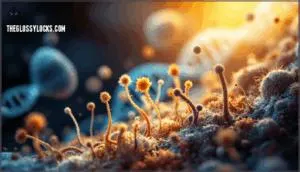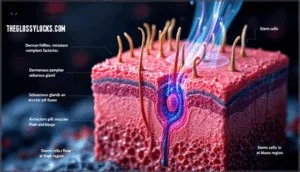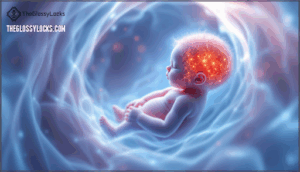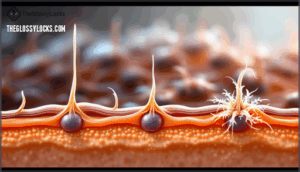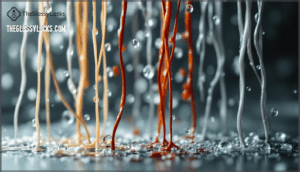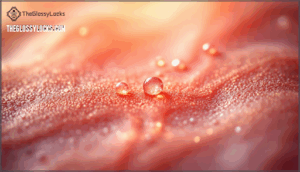This site is supported by our readers. We may earn a commission, at no cost to you, if you purchase through links.

Each follicle operates on its own growth cycle, which means you lose 50 to 100 hairs daily without actually going bald. The follicle count you’re born with stays fixed for life, but the density and health of those follicles determine how thick your hair appears.
Table Of Contents
- Key Takeaways
- How Many Hairs Are on a Human Head?
- What Factors Influence Hair Count?
- The Science of Hair Follicles
- Hair Growth Cycle Explained
- How Many Hairs Are Lost Daily?
- Can You Increase Hair Count or Density?
- Frequently Asked Questions (FAQs)
- How many hair strands are in a human head?
- How many hair follicles are on a human head?
- How many hairs are on your head?
- How many hairs does a human scalp have?
- How many hairs does a man have?
- How many hairs does the average person have a day?
- Does hair have DNA on it?
- Can you determine age from hair?
- How to detect hair loss?
- How many hairs are on an average head?
- Conclusion
Key Takeaways
- Your scalp contains a fixed number of hair follicles (80,000 to 150,000) that’s determined at birth and varies by hair color, with blondes averaging 150,000 strands and redheads around 90,000.
- Losing 50 to 100 hairs daily is completely normal because each follicle operates on its own growth cycle, with 85-90% actively growing while others rest or shed.
- You can’t create new follicles after birth, but you can maximize hair density and health through proper scalp care, nutrition, and medical treatments like minoxidil or PRP therapy.
- Hair follicle density varies significantly across your scalp and by ethnicity—the crown typically has 89% more density than the frontal areas, and Caucasians average 1,458 hairs per square inch compared to 961 for African descent individuals.
How Many Hairs Are on a Human Head?
The number of hairs on your head isn’t a one-size-fits-all answer. It depends on factors like your natural hair color, genetics, and individual characteristics.
Let’s break down the specifics so you understand what’s normal for you.
Average Hair Count by Hair Color
Your hair count depends on your natural color. Blonde hair leads with about 150,000 strands per head, while brown hair averages 110,000. Black hair count sits at roughly 100,000 strands. Redhead hair density comes in lowest at 90,000 strands.
This genetic color influence affects how thick your hair appears, even when overall hair density varies between individuals. Understanding hair follicle density aids in evaluating hair health.
Range of Hair Density in Individuals
Beyond color, your individual hair count can range anywhere from 80,000 to 150,000 strands. Density measurement reveals that average hair count on head varies by several factors:
- Age: Younger adults ages 20-30 show the highest density, declining after 35
- Ethnicity: Caucasians average 1,458 hairs per square inch at the crown, Hispanics 1,148, and individuals of African descent 961
- Scalp region: The back of your head usually holds 89% more density than frontal areas
- Individual variation: Extreme densities span from 62 to 266 hairs per square centimeter
These density factors matter when evaluating hair health or considering restoration impact options. The average person has around 100,000 hairs on their head.
Hair Follicle Count Vs. Hair Strand Count
Your follicles and strands aren’t quite the same thing, though people often mix them up. A follicle is the tiny pocket in your scalp where hair grows, while the strand is the visible hair itself. Here’s the key difference:
| Feature | Hair Follicles | Hair Strands |
|---|---|---|
| Count | Fixed at birth (100,000 average) | Matches follicle count when active |
| Lifespan | Permanent structure with growth potential | 2-7 years per cycle, then sheds |
| Density correlation | Determines maximum hair count | Reflects active growth phase only |
Not every follicle produces a strand at once. About 85-90% are actively growing hair, while others rest or shed. This explains why your average hair count on head (around 100,000 strands) matches your hair follicle count, but the actual visible hair varies daily.
Strand thickness and replacement limits also depend on follicle health, and factors affecting hair count include the natural growth cycle rather than new follicle creation.
What Factors Influence Hair Count?
Your hair count isn’t set in stone—it shifts based on a few key factors. Genetics plays the biggest role in determining how many follicles you’re born with, while age affects how many hairs you keep over time.
Let’s break down what really influences the number of hairs on your head.
Genetics and Hereditary Traits
Think of genetics as a blueprint passed down from your parents. Your genes determine your hair color, follicle count, and hair density before you’re even born. If your family has thick hair, you likely inherited more follicles.
Your genes act as an inherited blueprint, dictating hair color, follicle count, and density long before birth
Hair color genes also affect density—blonde hair averages 150,000 strands, while red hair averages 90,000. Genetics even influence your growth cycle and baldness predisposition, explaining why some people experience hair loss earlier than others.
Age and Natural Hair Shedding
As you get older, your hair naturally sheds more and the growth cycle slows down. After age 30, the likelihood of graying increases by 10-20% each decade. Hormonal changes and follicle aging contribute to density decline.
Aging affects your hair in these ways:
- Shedding increase occurs as follicles weaken over time
- Hair growth slows because the anagen phase shortens
- Density decline happens when fewer follicles remain active
- Graying impact results from reduced melanin production
- Hair loss accelerates due to hormonal changes and genetics
The Science of Hair Follicles
Your hair follicles are like tiny factories that work around the clock to produce each strand on your head. These specialized structures aren’t just simple pores—they’re complex biological systems with specific roles in hair growth and maintenance.
Let’s break down how follicles function, when they’re established, and why their density varies from person to person.
Hair Follicle Structure and Function
Each hair follicle on your scalp works like a tiny factory, producing individual strands through a complex biological process. The follicle anatomy includes the dermal papilla at its base, which supplies nutrients and signals for growth.
Surrounding each follicle are sebaceous glands that produce natural oils and arrector pili muscles that make hairs stand up.
Follicle stem cells at the bulge region continuously regenerate the structures needed for hair production. This intricate system determines your hair density and individual hair characteristics.
Follicle Count Established at Birth
By the time you’re born, your complete set of hair follicles is already in place. Fetal follicle development begins around nine weeks, with follicles first appearing on the eyebrows and upper lip.
By four to five months of gestation, your scalp receives its full complement of roughly 100,000 follicles. Postnatal follicle maturation continues, but genetic follicle determination means no new follicles form after birth—your hair density potential is set from day one.
Variations in Follicle Density
Your scalp doesn’t have an even spread of follicles—some spots pack in more hairs per square inch than others. Hair follicle density varies by scalp area, with the crown usually showing higher concentrations than the temples.
Ethnic density differences also play a role—Asian hair averages 150 to 175 follicles per square centimeter, while Caucasian hair ranges from 124 to 200.
Follicle grouping patterns matter too, as hairs naturally cluster in groups of one to four strands, affecting overall hair density measurement techniques and appearance.
Hair Growth Cycle Explained
Your hair doesn’t grow all at once. Each strand moves through three distinct phases that determine when it grows, when it stops, and when it falls out.
Understanding these phases explains why you naturally shed hair every day and why your hair only grows to a certain length.
Anagen (Growth) Phase
The anagen phase is where the real magic happens—this is when your hair actively grows from the follicle, and it can last anywhere from two to six years. During this time, hair grows about half an inch each month.
The length of your anagen phase depends on genetics and follicle health. About 85 to 90 percent of your hair follicles are in this growth stage right now.
Catagen (Transition) Phase
After that active growth wraps up, your hair doesn’t just fall out—it enters a brief intermediate stage called catagen. This stage, known as the Catagen Transition Phase, lasts about one to two weeks.
During this phase, your follicle shrinks and detaches from its blood supply, leading to growth cessation as the hair strand separates from the root. Importantly, this stage affects only a small percentage of your hair at any time.
Telogen (Resting and Shedding) Phase
Once the resting phase kicks in, your hair takes a break for about three months before naturally shedding from the follicle. This Telogen Resting Phase involves follicle dormancy, where no new growth occurs. Around 10-15% of your hair is in this stage at any time.
When the shedding duration ends, the cycle restart begins, and new growth pushes out the old strand.
Excessive hair shedding may indicate Telogen effluvium, a temporary hair loss condition affecting the hair growth cycle.
How Many Hairs Are Lost Daily?
You lose hair every day as part of your natural growth cycle. The amount you shed can vary based on several factors, from your age to how you treat your hair.
Understanding what’s normal—and what’s not—helps you spot potential problems early.
Normal Shedding Range
Generally, you’ll shed between 50 and 100 hairs each day through the natural hair growth cycle. Studies show this range can vary from 40 to 150 strands based on individual factors and how you measure hair loss. Here’s what influences normal shedding:
- Hair washing days show higher counts since shampooing releases loose strands
- About 8 to 9 percent of your follicles are in the telogen (shedding) phase at once
- Women often report more daily hair loss than men due to styling and hormonal factors
- Hair length and thickness affect how much shedding you notice in the shower or brush
- Wash frequency matters—daily washing spreads out shedding versus weekly washing
Scientists base the "100 hairs per day" standard on simple math: with roughly 100,000 scalp hairs and 10% in the shedding phase, that equals about 100 daily. The wash test method reports normal ranges between 105 and 250 shed hairs after five days without washing. Keep in mind that hair density and your personal hair growth cycle create natural shedding variation throughout the year.
Factors That Affect Daily Hair Loss
Several everyday factors can push your daily hair loss above or below that 50-to-100 range. Stress and loss connect directly—your body reacts to physical or emotional strain by shifting more follicles into the shedding phase. Hormonal changes during pregnancy, menopause, or thyroid issues alter normal patterns.
Diet and loss matter too, since iron deficiency or low protein intake disrupts your hair growth cycle. Medications like blood thinners or chemotherapy drugs trigger excessive hair shedding per day.
Scalp conditions including dandruff or inflammation damage follicles and increase hair loss causes. Environmental factors like harsh styling, chemical treatments, and seasonal changes also influence daily shedding rates.
Signs of Abnormal Hair Loss
Most people won’t notice losing 100 hairs a day, but certain warning signs tell you when shedding crosses into problem territory. Excessive shedding that clogs drains or leaves clumps on your pillow signals trouble. Patchy baldness and rapid thinning expose visible scalp areas.
Scalp changes like redness or flaking accompany hair loss conditions. Hair breakage creates shorter strands that reduce overall hair density beyond normal hair shedding per day.
Can You Increase Hair Count or Density?
You can’t create new hair follicles, but you can improve the health and thickness of the hair you have. Your scalp condition, diet, and treatment options all play a role in maximizing your hair’s potential.
Let’s look at three key areas that can help you get the most from your existing follicles.
Hair Care and Scalp Health
Your scalp health isn’t just about what you see on the surface—it’s the foundation that determines whether your hair follicles can do their job effectively. Proper hair care protects the scalp microbiome and fosters hair density through these key practices:
- Washing frequency should match your scalp’s oil production without stripping natural protection
- Product ingredients matter—avoid harsh sulfates that disrupt scalp balance
- Protective styling reduces mechanical stress on hair strands
Maintaining hair hydration and scalp circulation creates the ideal environment for hair growth.
Nutrition and Lifestyle Factors
What you eat and how you live doesn’t just affect your waistline—it directly influences how many hair follicles stay active on your head. Dietary impact shows that protein and iron deficiencies reduce hair growth, while stress effects and smoking influence constrict blood flow to follicles.
Hydration levels support hair health, and exercise benefits improve circulation. These lifestyle factors determine whether you maintain or lose hair density.
Medical Treatments and Hair Restoration Options
Beyond nutrition and lifestyle changes, medical hair loss treatments offer targeted ways to restore density. PRP therapy shows success rates of 70-80% for early hair loss, while hair transplants achieve up to 98% graft survival with techniques like FUE.
Topical solutions such as minoxidil and laser therapy slow thinning without surgery.
Emerging options like stem cells and AI-guided hair restoration services expand your hair loss prevention choices in 2025.
Frequently Asked Questions (FAQs)
How many hair strands are in a human head?
The average human head has about 100,000 hairs, though this varies by hair color. Blonde hair averages 150,000 strands, brown hair around 110,000, black hair 100,000, and red hair 90,
Hair density and individual differences affect these numbers greatly.
How many hair follicles are on a human head?
The human head has around 100,000 hair follicles. This follicle count stays fixed from birth and matches the number of scalp hair strands you can grow.
Follicle distribution and follicle health determine your hair density and coverage.
How many hairs are on your head?
Think of your scalp like a crowded stadium—those seats are nearly full. The average person has around 100,000 hairs on their head, though individual hair variation ranges from 90,000 to 150,
Hair count averages shift with hair color correlation too.
How many hairs does a human scalp have?
The average person has between 90,000 and 150,000 hair follicles on their scalp.
Hair count variance depends on your hair color and genetics. Blonde hair usually shows the highest scalp coverage density at 150,000 hairs.
How many hairs does a man have?
Men usually have between 90,000 and 150,000 hairs on their heads. Male pattern baldness and testosterone influence can reduce hair density over time.
Hair density varies by genetics, age, and hairline recession patterns. Shaving effects don’t change follicle count.
How many hairs does the average person have a day?
On average, daily hair shedding ranges from 50 to 100 hairs. This is normal since about 85-90% of your 100,000 hairs are growing while others rest and shed.
Seasonal hair loss and various hair loss triggers can affect this count.
Does hair have DNA on it?
Yes, hair contains DNA. Hair follicles provide the best DNA source for testing. The follicle root holds high-quality follicular DNA.
Hair shafts contain less DNA and face degradation factors over time. DNA extraction methods vary based on hair strand condition.
Can you determine age from hair?
Hair follicle analysis can reveal some age-related changes like gray hair onset, hair diameter decrease, and hair growth slowdown. However, pinpointing exact age isn’t reliable.
Hair texture changes and telogen effluvium patterns vary widely between individuals due to genetics and lifestyle factors.
How to detect hair loss?
Early symptoms include noticing increased shedding vs loss—more than 100 hairs daily. Self-examination reveals widening parts or scalp visibility.
Tracking changes in hair density helps identify hair thinning patterns.
Professional diagnosis determines specific hair loss causes for proper hair loss diagnosis and treatment.
How many hairs are on an average head?
It’s no hair-splitting matter—your head usually holds about 100,000 hairs. Blonde hair count averages 150,000, while redhead hair stats show around 90,
Individual hair variance spans 90,000 to 150,000 strands, with hair count factors like genetics affecting average hair density.
Conclusion
Your scalp might lose 100 strands daily, but that’s barely a drop in the ocean when you’ve got up to 150,000 follicles working overtime. Understanding how many hairs are on a human head helps you separate normal shedding from real problems.
Your follicle count won’t change, but how you treat your scalp determines whether those follicles keep producing thick, healthy hair or gradually thin out over time.

